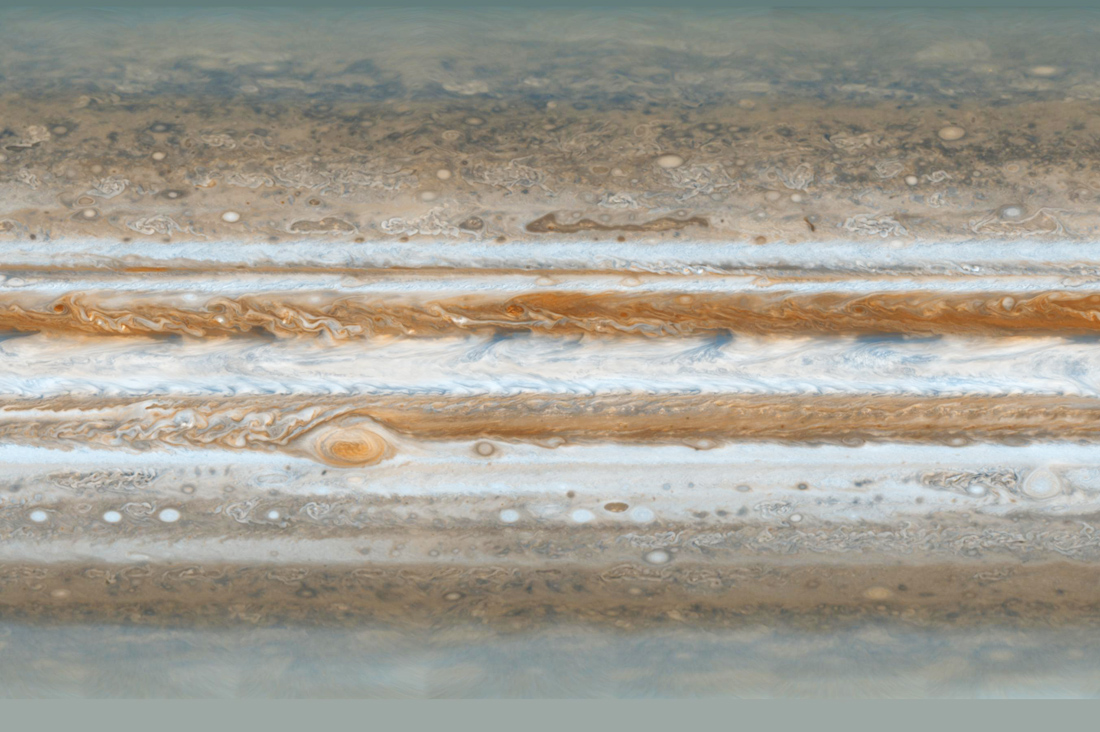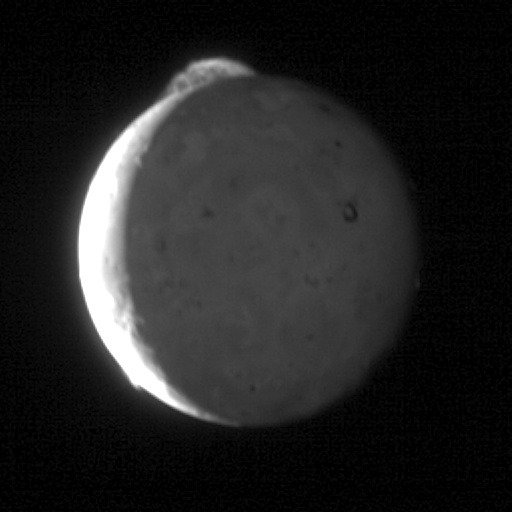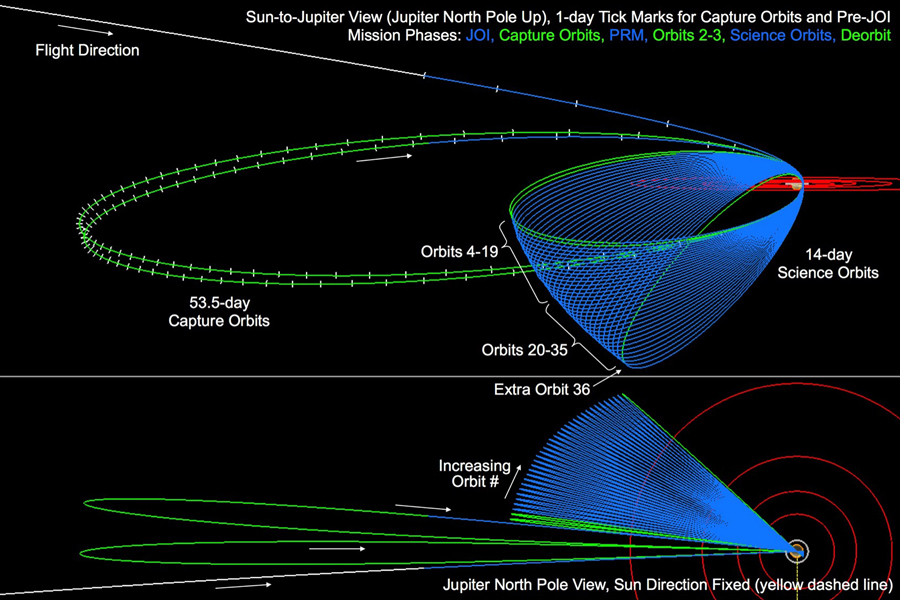The secret life of the giants

NASA Juno probe successfully entered intermediate orbit around the giant planet Jupiter, telling what and how it will study after the start of scientific work.
According to the common joke Juno, the wife of Jupiter, flies to find out how he spends time with his mistresses and lovers. In fact, the mission of Juno does not apply to the relationship of Jupiter and its satellites, this study is entirely devoted to the giant.
The main scientific tasks Juno - better to know the structure of Jupiter. This knowledge will help to better understand the structure of the planet, and learn more about the processes of formation of gas giants in the Solar and other planetary systems. Jupiter is a unique body for our system - almost a transitional form from a planet to a brown dwarf. To become a brown dwarf, Jupiter will need to find somewhere else a dozen of his twins, and to reach the status of a star - eight dozen. However, Jupiter is not at all the planet of the earthly type, which is now the best studied. Just under a few hundred kilometers of a helium-hydrogen gas atmosphere, Jupiter is filled with a sea of liquid hydrogen, at the bottom of which even more exotic matter is metallic hydrogen. Huge pressure and temperatures form the conditions that are simply impossible to imagine on Earth, you can only carry out mathematical modeling or obtain milligrams of a similar substance in the laboratory. How are the layers distributed in the depths of Jupiter, what processes occur there, is there a solid core in the very center? Juno should answer these questions.
')

A glance at the Big Red Spot will make it possible to see not only the rich inner world of Jupiter, but also a better understanding of the formation of planetary systems and more exotic objects of the Universe: brown dwarfs.
Juno is equipped with instruments that will, each in its own way, extract knowledge from the Jovian depths.

The outer gas envelope is the most accessible for study, therefore, it is aimed at most of all devices, but the processes occurring in the Jupiter clouds must prompt what is going on deeper. The outer atmosphere of Jupiter will be studied by two spectrometers: infrared and ultraviolet. For the "mass viewer" a separate camera is installed, which shoots in the visible range - its task is to delight us with beautiful photos until it dies from radiation.

The infrared camera will allow you to see the heat flow in the atmosphere at a depth of 70 km. To make the infrared data on Jupiter more complete, it was observed in advance with the help of ground-based telescopes, including the European VLT .

In the ultraviolet, the aurora of Jupiter will be observed. Now this is only the telescope Hubble.

Aurora scientists are interested not only from an aesthetic point of view. The magnetic field of Jupiter is the strongest of the planets of the solar system. It is the cause of the formation of the most powerful radiation belts, and the tail of the magnetosphere stretches hundreds of millions of kilometers right up to the orbit of Saturn. The nature of its formation lurks in the depths of Jupiter and is associated with the flow of liquid metallic hydrogen in the outer core of the giant planet, so the study of the magnetic field and radiation belts is another important Juno task.
For example, it is already known that in Jupiter, as well as on Earth, the geographic pole does not coincide with the magnetic one, because of which the giant flirts its radiation belts coquettishly.

Unlike Earth, Jupiter has its own source of charged particles, which fills the radiation belts. We have to wait for a solar flare to see the aurora, and Jupiter just enough another major eruption on the nearest large satellite Io. And since Io always boils, fireworks at the poles of Jupiter are not uncommon.

Io volcanoes emit dust and gases, the atoms of which are ionized by solar ultraviolet and replenish Jupiter’s magnetosphere, becoming a big problem for spacecraft and possible future explorers of Europe.
To study charged particles and plasma, Juno is equipped with two sensors for low-energy and high-energy particles. A special antenna will study the radio waves that are created by auroras.
The magnetic field will be mapped using a magnetometer, located on one of the "wings" of the spacecraft. This device is very sensitive to changes in the magnetic field, so they tried to take it as far as possible from Juno electrical equipment.

To improve the accuracy of the readings, the magnetometer is equipped with stellar sensors that can determine the position of the device using the stars. When Juno flew past the Earth, the star sensors were able to be tested and simultaneously used as a video camera.

A glance at the very core of the atmosphere of Jupiter Juno will produce using a microwave radiometer. It will allow to observe heat flows at a depth of up to 600 km.
Finally, perhaps one of the most important studies will be carried out by recording the deviations of the gravitational field of the planet. The result should be an understanding of the structure of Jupiter, the distribution of layers, the refinement of the mass of its core, and a more accurate understanding of its composition. Oddly enough, for these purposes is not intended a separate device. The analysis will be carried out using a radio signal: the inhomogeneities of the gravitational field will change the speed of the spacecraft by negligible fractions of a spacecraft and these deviations will be determined on Earth by the Doppler effect, which will lengthen or shorten the Juno radio signal.
The spacecraft will rotate along an elongated polar elliptical orbit, moving away by 3.5 million km and moving closer by 5 thousand km. Due to this, we will be able to see for the first time the poles of Jupiter, which have not yet been able to remove any probe.

Each orbit in orbit will take 14 days. This orbit is intended for exploratory work, but Juno will not immediately enter it. The work of Jupiter will begin with the 53.5-day orbit, and the stage of scientific work will begin only in November 2016. In less than a year and a half, by February 2018, Juno’s mission will be completed and the device will be brought together in the dense layers of the atmosphere of the giant planet.

Such a complete destruction of the apparatus is envisaged in order to avoid the danger of contamination by the earth microorganisms of the surface of the satellites of Jupiter, above all Europe, where they hope to find their own life.

If you're lucky, during Juno's work on Jupiter, another large asteroid will fall, and this event will be explored with all the tools. As ground observations show, such collisions are not rare for Jupiter, although the predecessor of Juno, the Galileo probe, was even more fortunate in the 90s — he was able to observe the fall of the Shotmaker-Levy 9 comet in 1994.

It is curious that so far in the upper atmosphere of Jupiter there is an increased water content in those regions where the comet fragments fell. This discovery was made by the Herschel infrared telescope, and Juno will also try to estimate the water supply.
Juno is not the first explorer of Jupiter, but most of the probes flew past and studied only from flying trajectories.
Almost always, the giant was used to accelerate gravitational maneuvers, and only in the 90s the NASA Galileo machine flew to it.
Unlike Galileo, Juno will devote himself entirely to the study of Jupiter, conduct closer encounters and inspect the polar regions.
You can follow Juno's flight on the site whereisjuno.info , in the NASA Eyes desktop application, or in SolarWalk for iOS and Android .

Source: https://habr.com/ru/post/395889/
All Articles